Analysis of Public Participation: Enbridge Pipeline Case Study
VerifiedAdded on 2022/09/18
|13
|2655
|16
Case Study
AI Summary
This case study examines the Enbridge Northern Gateway Pipeline project, focusing on public participation and social impact assessment within the context of Canadian environmental assessment processes. The report analyzes the project's context, including its scale and environmental risks, and explores the formal arrangements for public participation as mandated by Canadian environmental laws. It investigates the roles and interests of key actors, particularly Indigenous communities and the Canadian government, and assesses the nature and impact of actual public participation activities. The study highlights factors that either facilitated or discouraged public involvement, such as the promise of economic benefits versus environmental concerns. The case study concludes by reflecting on the effectiveness of public participation in the project's approval and subsequent cancellation, emphasizing the importance of genuine stakeholder engagement in environmental decision-making.
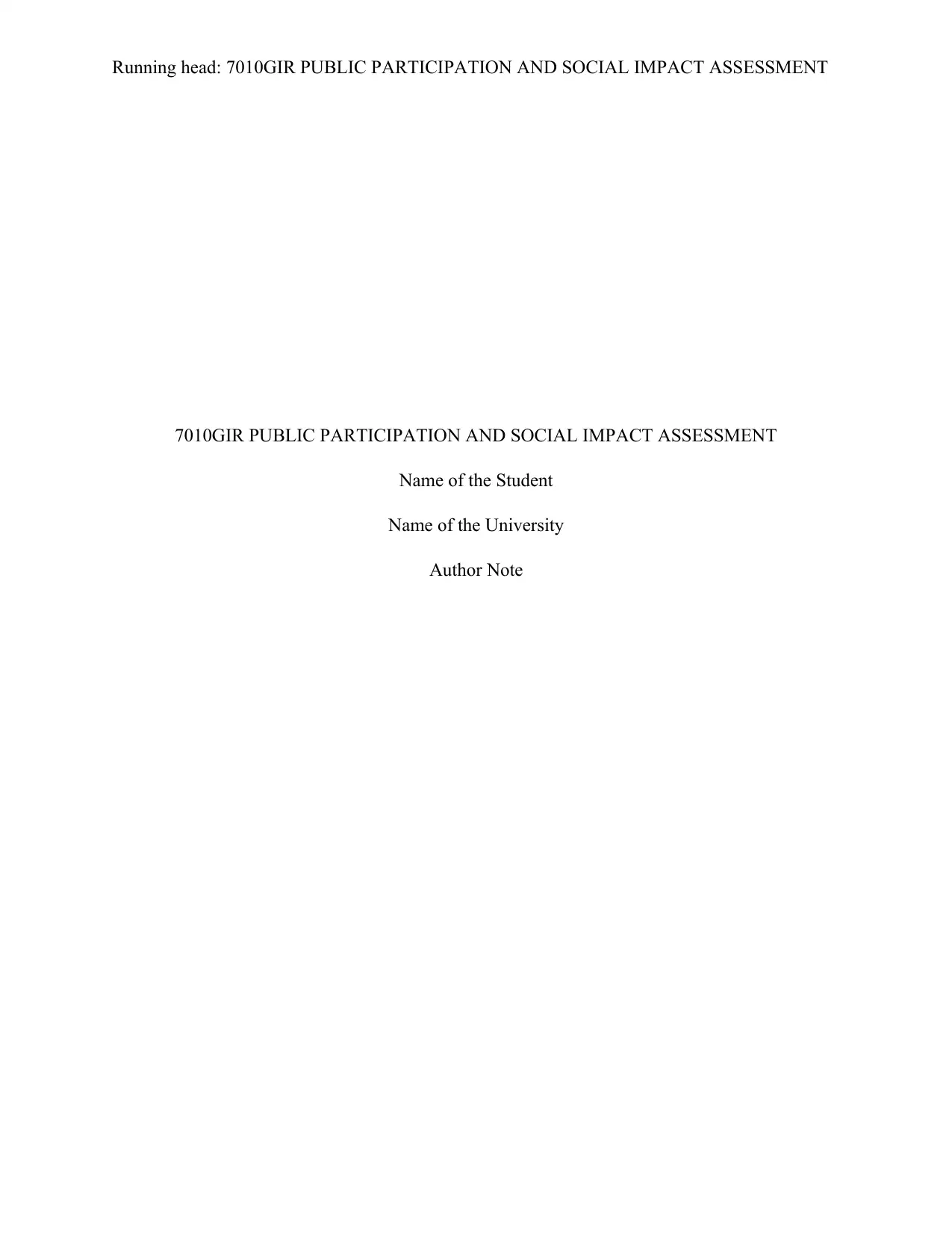
Running head: 7010GIR PUBLIC PARTICIPATION AND SOCIAL IMPACT ASSESSMENT
7010GIR PUBLIC PARTICIPATION AND SOCIAL IMPACT ASSESSMENT
Name of the Student
Name of the University
Author Note
7010GIR PUBLIC PARTICIPATION AND SOCIAL IMPACT ASSESSMENT
Name of the Student
Name of the University
Author Note
Paraphrase This Document
Need a fresh take? Get an instant paraphrase of this document with our AI Paraphraser
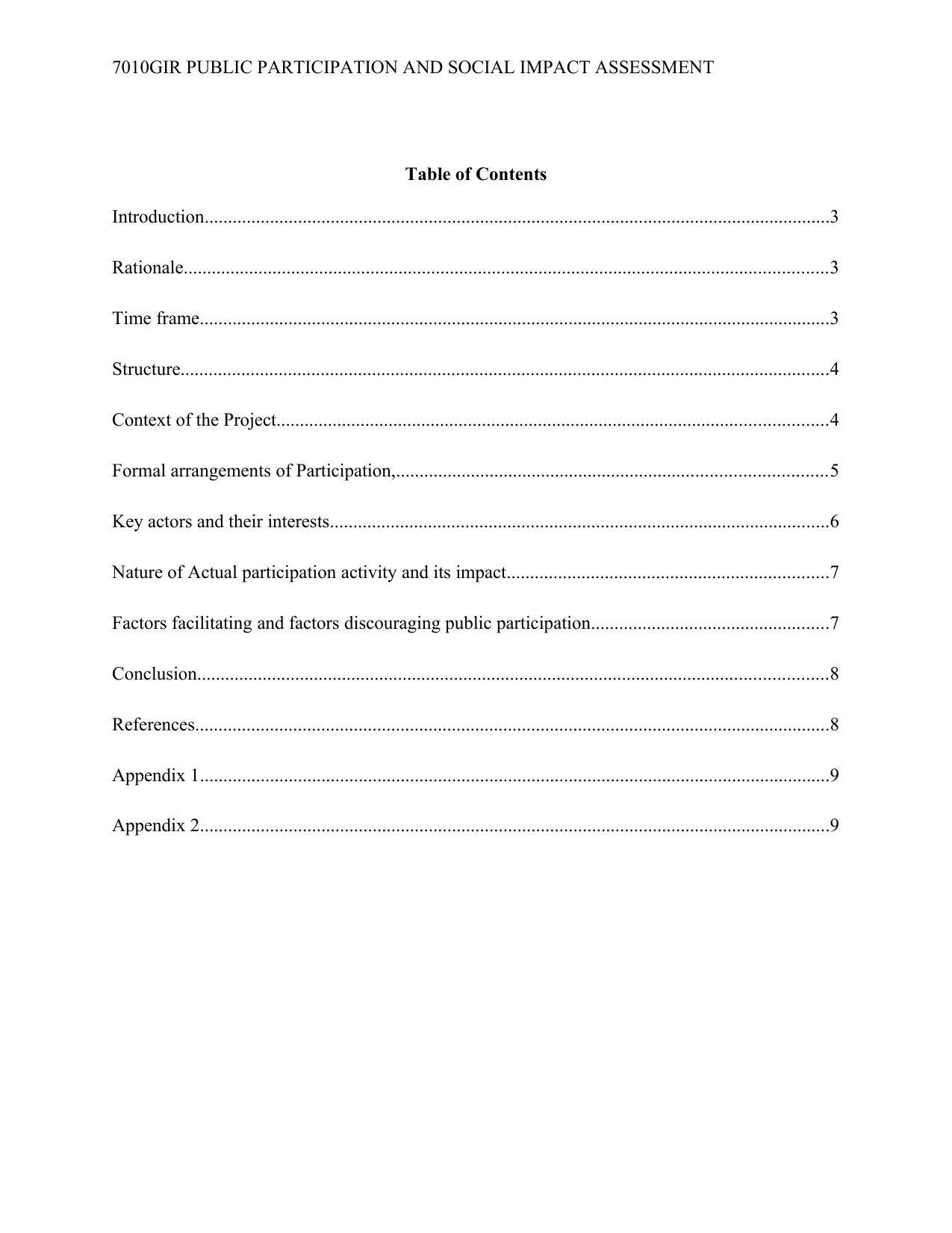
7010GIR PUBLIC PARTICIPATION AND SOCIAL IMPACT ASSESSMENT
Table of Contents
Introduction......................................................................................................................................3
Rationale..........................................................................................................................................3
Time frame.......................................................................................................................................3
Structure...........................................................................................................................................4
Context of the Project......................................................................................................................4
Formal arrangements of Participation,............................................................................................5
Key actors and their interests...........................................................................................................6
Nature of Actual participation activity and its impact.....................................................................7
Factors facilitating and factors discouraging public participation...................................................7
Conclusion.......................................................................................................................................8
References........................................................................................................................................8
Appendix 1.......................................................................................................................................9
Appendix 2.......................................................................................................................................9
Table of Contents
Introduction......................................................................................................................................3
Rationale..........................................................................................................................................3
Time frame.......................................................................................................................................3
Structure...........................................................................................................................................4
Context of the Project......................................................................................................................4
Formal arrangements of Participation,............................................................................................5
Key actors and their interests...........................................................................................................6
Nature of Actual participation activity and its impact.....................................................................7
Factors facilitating and factors discouraging public participation...................................................7
Conclusion.......................................................................................................................................8
References........................................................................................................................................8
Appendix 1.......................................................................................................................................9
Appendix 2.......................................................................................................................................9
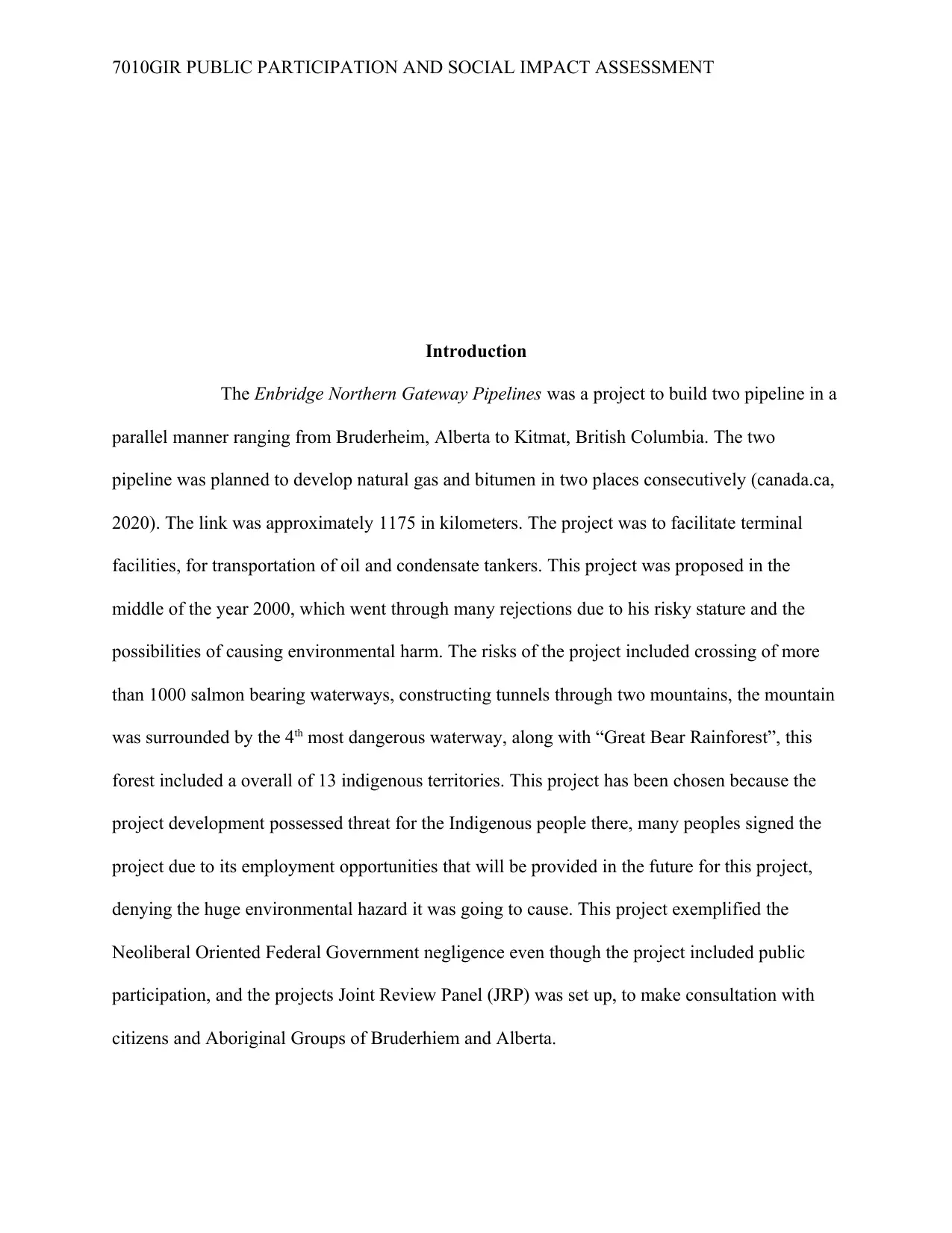
7010GIR PUBLIC PARTICIPATION AND SOCIAL IMPACT ASSESSMENT
Introduction
The Enbridge Northern Gateway Pipelines was a project to build two pipeline in a
parallel manner ranging from Bruderheim, Alberta to Kitmat, British Columbia. The two
pipeline was planned to develop natural gas and bitumen in two places consecutively (canada.ca,
2020). The link was approximately 1175 in kilometers. The project was to facilitate terminal
facilities, for transportation of oil and condensate tankers. This project was proposed in the
middle of the year 2000, which went through many rejections due to his risky stature and the
possibilities of causing environmental harm. The risks of the project included crossing of more
than 1000 salmon bearing waterways, constructing tunnels through two mountains, the mountain
was surrounded by the 4th most dangerous waterway, along with “Great Bear Rainforest”, this
forest included a overall of 13 indigenous territories. This project has been chosen because the
project development possessed threat for the Indigenous people there, many peoples signed the
project due to its employment opportunities that will be provided in the future for this project,
denying the huge environmental hazard it was going to cause. This project exemplified the
Neoliberal Oriented Federal Government negligence even though the project included public
participation, and the projects Joint Review Panel (JRP) was set up, to make consultation with
citizens and Aboriginal Groups of Bruderhiem and Alberta.
Introduction
The Enbridge Northern Gateway Pipelines was a project to build two pipeline in a
parallel manner ranging from Bruderheim, Alberta to Kitmat, British Columbia. The two
pipeline was planned to develop natural gas and bitumen in two places consecutively (canada.ca,
2020). The link was approximately 1175 in kilometers. The project was to facilitate terminal
facilities, for transportation of oil and condensate tankers. This project was proposed in the
middle of the year 2000, which went through many rejections due to his risky stature and the
possibilities of causing environmental harm. The risks of the project included crossing of more
than 1000 salmon bearing waterways, constructing tunnels through two mountains, the mountain
was surrounded by the 4th most dangerous waterway, along with “Great Bear Rainforest”, this
forest included a overall of 13 indigenous territories. This project has been chosen because the
project development possessed threat for the Indigenous people there, many peoples signed the
project due to its employment opportunities that will be provided in the future for this project,
denying the huge environmental hazard it was going to cause. This project exemplified the
Neoliberal Oriented Federal Government negligence even though the project included public
participation, and the projects Joint Review Panel (JRP) was set up, to make consultation with
citizens and Aboriginal Groups of Bruderhiem and Alberta.
⊘ This is a preview!⊘
Do you want full access?
Subscribe today to unlock all pages.

Trusted by 1+ million students worldwide
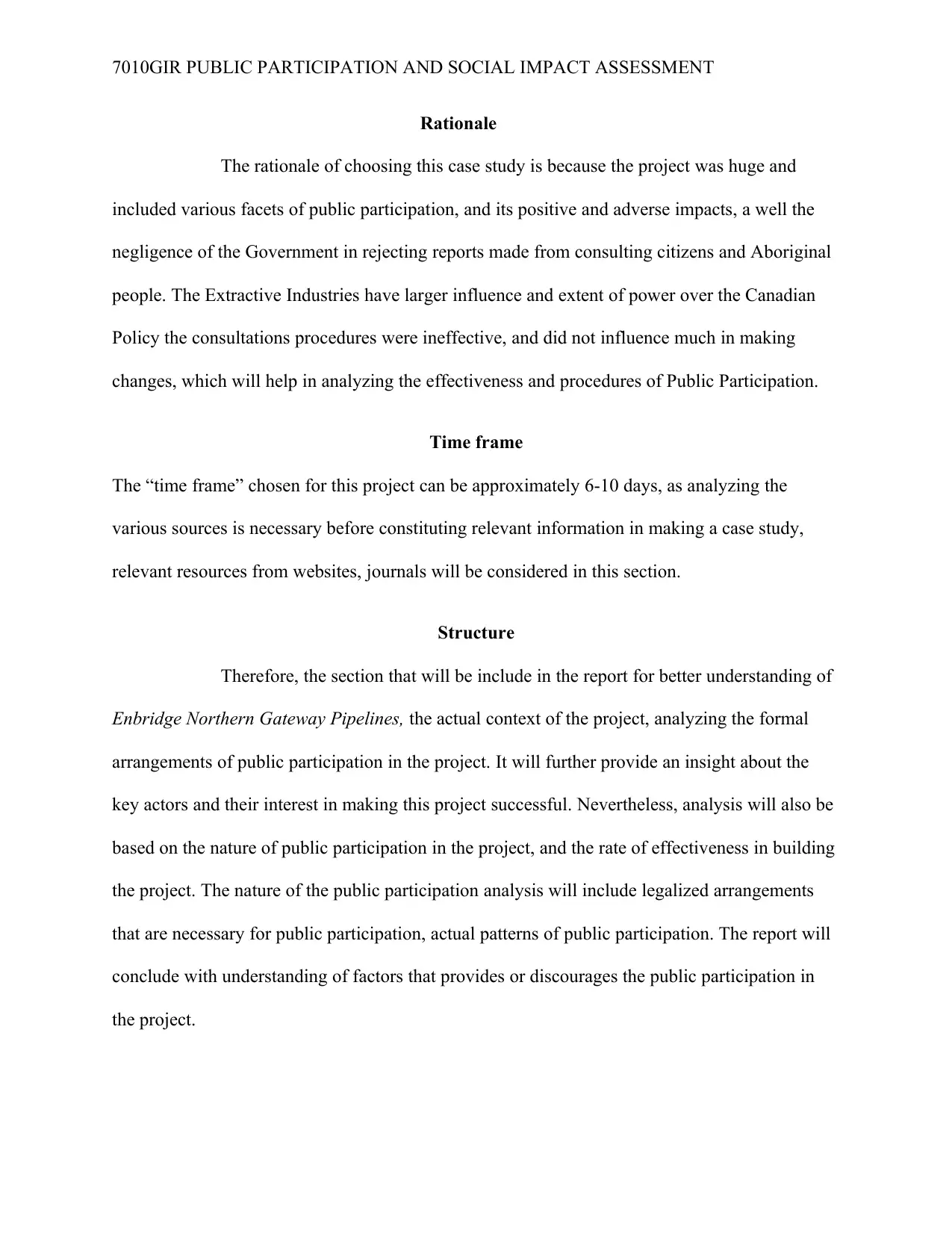
7010GIR PUBLIC PARTICIPATION AND SOCIAL IMPACT ASSESSMENT
Rationale
The rationale of choosing this case study is because the project was huge and
included various facets of public participation, and its positive and adverse impacts, a well the
negligence of the Government in rejecting reports made from consulting citizens and Aboriginal
people. The Extractive Industries have larger influence and extent of power over the Canadian
Policy the consultations procedures were ineffective, and did not influence much in making
changes, which will help in analyzing the effectiveness and procedures of Public Participation.
Time frame
The “time frame” chosen for this project can be approximately 6-10 days, as analyzing the
various sources is necessary before constituting relevant information in making a case study,
relevant resources from websites, journals will be considered in this section.
Structure
Therefore, the section that will be include in the report for better understanding of
Enbridge Northern Gateway Pipelines, the actual context of the project, analyzing the formal
arrangements of public participation in the project. It will further provide an insight about the
key actors and their interest in making this project successful. Nevertheless, analysis will also be
based on the nature of public participation in the project, and the rate of effectiveness in building
the project. The nature of the public participation analysis will include legalized arrangements
that are necessary for public participation, actual patterns of public participation. The report will
conclude with understanding of factors that provides or discourages the public participation in
the project.
Rationale
The rationale of choosing this case study is because the project was huge and
included various facets of public participation, and its positive and adverse impacts, a well the
negligence of the Government in rejecting reports made from consulting citizens and Aboriginal
people. The Extractive Industries have larger influence and extent of power over the Canadian
Policy the consultations procedures were ineffective, and did not influence much in making
changes, which will help in analyzing the effectiveness and procedures of Public Participation.
Time frame
The “time frame” chosen for this project can be approximately 6-10 days, as analyzing the
various sources is necessary before constituting relevant information in making a case study,
relevant resources from websites, journals will be considered in this section.
Structure
Therefore, the section that will be include in the report for better understanding of
Enbridge Northern Gateway Pipelines, the actual context of the project, analyzing the formal
arrangements of public participation in the project. It will further provide an insight about the
key actors and their interest in making this project successful. Nevertheless, analysis will also be
based on the nature of public participation in the project, and the rate of effectiveness in building
the project. The nature of the public participation analysis will include legalized arrangements
that are necessary for public participation, actual patterns of public participation. The report will
conclude with understanding of factors that provides or discourages the public participation in
the project.
Paraphrase This Document
Need a fresh take? Get an instant paraphrase of this document with our AI Paraphraser
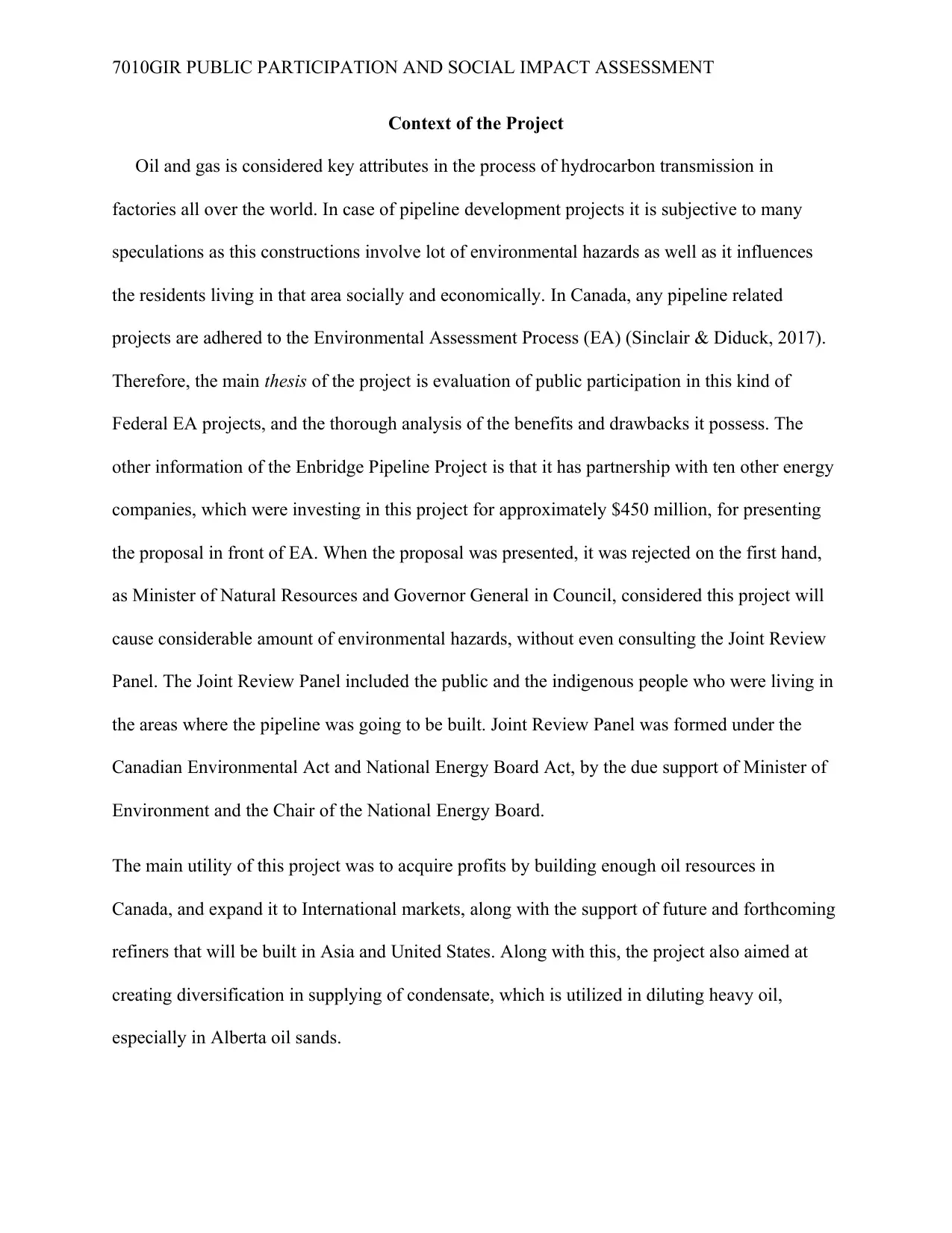
7010GIR PUBLIC PARTICIPATION AND SOCIAL IMPACT ASSESSMENT
Context of the Project
Oil and gas is considered key attributes in the process of hydrocarbon transmission in
factories all over the world. In case of pipeline development projects it is subjective to many
speculations as this constructions involve lot of environmental hazards as well as it influences
the residents living in that area socially and economically. In Canada, any pipeline related
projects are adhered to the Environmental Assessment Process (EA) (Sinclair & Diduck, 2017).
Therefore, the main thesis of the project is evaluation of public participation in this kind of
Federal EA projects, and the thorough analysis of the benefits and drawbacks it possess. The
other information of the Enbridge Pipeline Project is that it has partnership with ten other energy
companies, which were investing in this project for approximately $450 million, for presenting
the proposal in front of EA. When the proposal was presented, it was rejected on the first hand,
as Minister of Natural Resources and Governor General in Council, considered this project will
cause considerable amount of environmental hazards, without even consulting the Joint Review
Panel. The Joint Review Panel included the public and the indigenous people who were living in
the areas where the pipeline was going to be built. Joint Review Panel was formed under the
Canadian Environmental Act and National Energy Board Act, by the due support of Minister of
Environment and the Chair of the National Energy Board.
The main utility of this project was to acquire profits by building enough oil resources in
Canada, and expand it to International markets, along with the support of future and forthcoming
refiners that will be built in Asia and United States. Along with this, the project also aimed at
creating diversification in supplying of condensate, which is utilized in diluting heavy oil,
especially in Alberta oil sands.
Context of the Project
Oil and gas is considered key attributes in the process of hydrocarbon transmission in
factories all over the world. In case of pipeline development projects it is subjective to many
speculations as this constructions involve lot of environmental hazards as well as it influences
the residents living in that area socially and economically. In Canada, any pipeline related
projects are adhered to the Environmental Assessment Process (EA) (Sinclair & Diduck, 2017).
Therefore, the main thesis of the project is evaluation of public participation in this kind of
Federal EA projects, and the thorough analysis of the benefits and drawbacks it possess. The
other information of the Enbridge Pipeline Project is that it has partnership with ten other energy
companies, which were investing in this project for approximately $450 million, for presenting
the proposal in front of EA. When the proposal was presented, it was rejected on the first hand,
as Minister of Natural Resources and Governor General in Council, considered this project will
cause considerable amount of environmental hazards, without even consulting the Joint Review
Panel. The Joint Review Panel included the public and the indigenous people who were living in
the areas where the pipeline was going to be built. Joint Review Panel was formed under the
Canadian Environmental Act and National Energy Board Act, by the due support of Minister of
Environment and the Chair of the National Energy Board.
The main utility of this project was to acquire profits by building enough oil resources in
Canada, and expand it to International markets, along with the support of future and forthcoming
refiners that will be built in Asia and United States. Along with this, the project also aimed at
creating diversification in supplying of condensate, which is utilized in diluting heavy oil,
especially in Alberta oil sands.
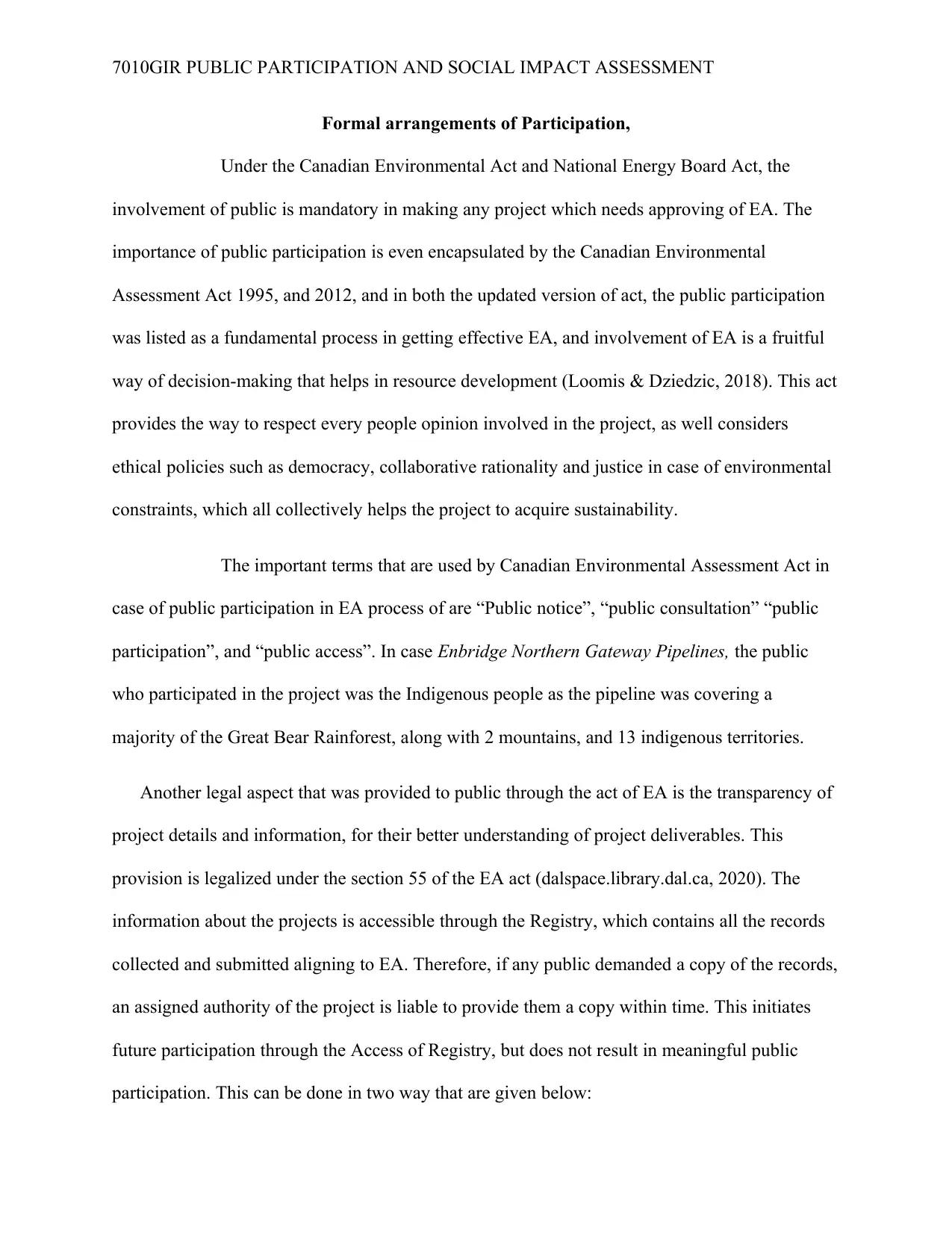
7010GIR PUBLIC PARTICIPATION AND SOCIAL IMPACT ASSESSMENT
Formal arrangements of Participation,
Under the Canadian Environmental Act and National Energy Board Act, the
involvement of public is mandatory in making any project which needs approving of EA. The
importance of public participation is even encapsulated by the Canadian Environmental
Assessment Act 1995, and 2012, and in both the updated version of act, the public participation
was listed as a fundamental process in getting effective EA, and involvement of EA is a fruitful
way of decision-making that helps in resource development (Loomis & Dziedzic, 2018). This act
provides the way to respect every people opinion involved in the project, as well considers
ethical policies such as democracy, collaborative rationality and justice in case of environmental
constraints, which all collectively helps the project to acquire sustainability.
The important terms that are used by Canadian Environmental Assessment Act in
case of public participation in EA process of are “Public notice”, “public consultation” “public
participation”, and “public access”. In case Enbridge Northern Gateway Pipelines, the public
who participated in the project was the Indigenous people as the pipeline was covering a
majority of the Great Bear Rainforest, along with 2 mountains, and 13 indigenous territories.
Another legal aspect that was provided to public through the act of EA is the transparency of
project details and information, for their better understanding of project deliverables. This
provision is legalized under the section 55 of the EA act (dalspace.library.dal.ca, 2020). The
information about the projects is accessible through the Registry, which contains all the records
collected and submitted aligning to EA. Therefore, if any public demanded a copy of the records,
an assigned authority of the project is liable to provide them a copy within time. This initiates
future participation through the Access of Registry, but does not result in meaningful public
participation. This can be done in two way that are given below:
Formal arrangements of Participation,
Under the Canadian Environmental Act and National Energy Board Act, the
involvement of public is mandatory in making any project which needs approving of EA. The
importance of public participation is even encapsulated by the Canadian Environmental
Assessment Act 1995, and 2012, and in both the updated version of act, the public participation
was listed as a fundamental process in getting effective EA, and involvement of EA is a fruitful
way of decision-making that helps in resource development (Loomis & Dziedzic, 2018). This act
provides the way to respect every people opinion involved in the project, as well considers
ethical policies such as democracy, collaborative rationality and justice in case of environmental
constraints, which all collectively helps the project to acquire sustainability.
The important terms that are used by Canadian Environmental Assessment Act in
case of public participation in EA process of are “Public notice”, “public consultation” “public
participation”, and “public access”. In case Enbridge Northern Gateway Pipelines, the public
who participated in the project was the Indigenous people as the pipeline was covering a
majority of the Great Bear Rainforest, along with 2 mountains, and 13 indigenous territories.
Another legal aspect that was provided to public through the act of EA is the transparency of
project details and information, for their better understanding of project deliverables. This
provision is legalized under the section 55 of the EA act (dalspace.library.dal.ca, 2020). The
information about the projects is accessible through the Registry, which contains all the records
collected and submitted aligning to EA. Therefore, if any public demanded a copy of the records,
an assigned authority of the project is liable to provide them a copy within time. This initiates
future participation through the Access of Registry, but does not result in meaningful public
participation. This can be done in two way that are given below:
⊘ This is a preview!⊘
Do you want full access?
Subscribe today to unlock all pages.

Trusted by 1+ million students worldwide
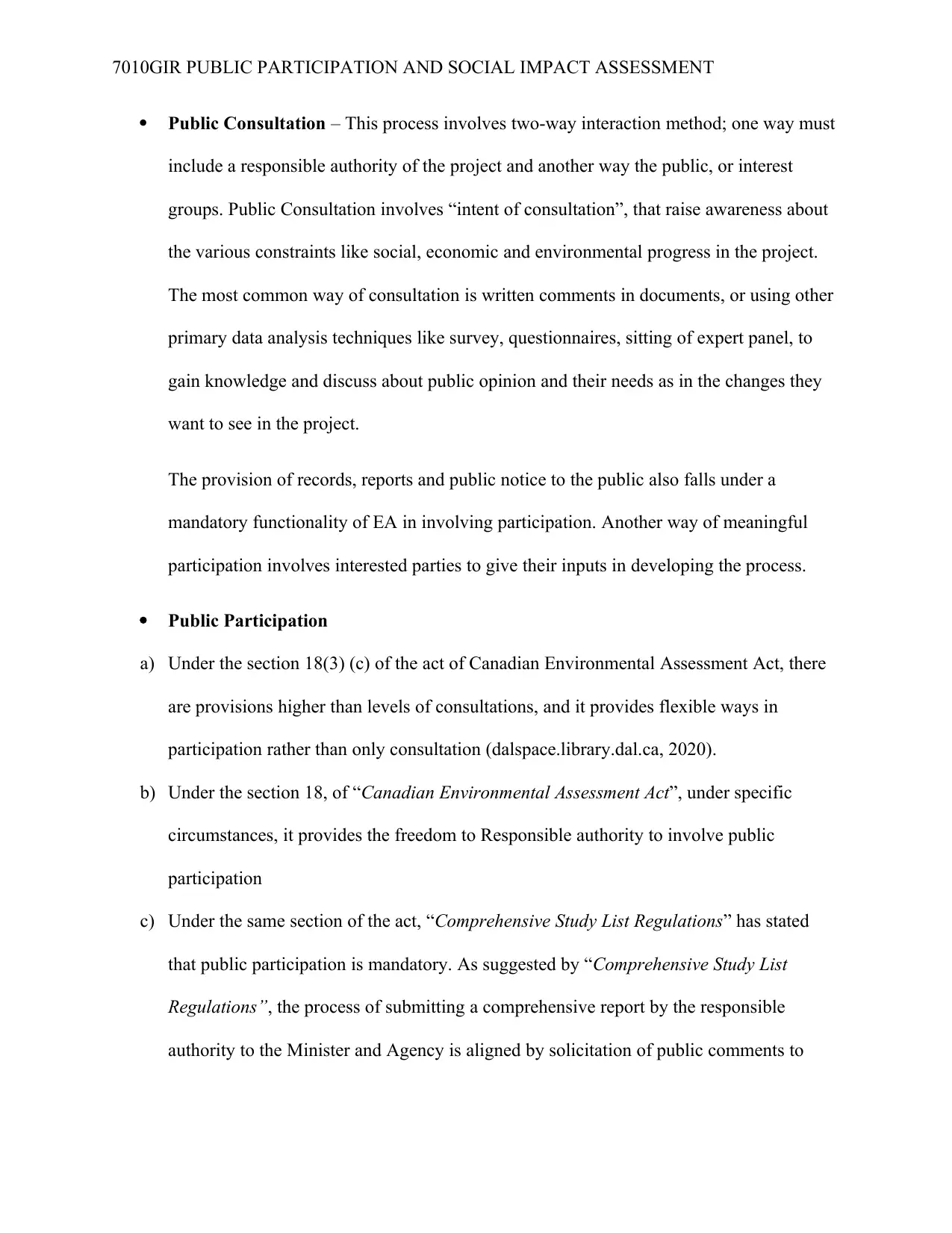
7010GIR PUBLIC PARTICIPATION AND SOCIAL IMPACT ASSESSMENT
Public Consultation – This process involves two-way interaction method; one way must
include a responsible authority of the project and another way the public, or interest
groups. Public Consultation involves “intent of consultation”, that raise awareness about
the various constraints like social, economic and environmental progress in the project.
The most common way of consultation is written comments in documents, or using other
primary data analysis techniques like survey, questionnaires, sitting of expert panel, to
gain knowledge and discuss about public opinion and their needs as in the changes they
want to see in the project.
The provision of records, reports and public notice to the public also falls under a
mandatory functionality of EA in involving participation. Another way of meaningful
participation involves interested parties to give their inputs in developing the process.
Public Participation
a) Under the section 18(3) (c) of the act of Canadian Environmental Assessment Act, there
are provisions higher than levels of consultations, and it provides flexible ways in
participation rather than only consultation (dalspace.library.dal.ca, 2020).
b) Under the section 18, of “Canadian Environmental Assessment Act”, under specific
circumstances, it provides the freedom to Responsible authority to involve public
participation
c) Under the same section of the act, “Comprehensive Study List Regulations” has stated
that public participation is mandatory. As suggested by “Comprehensive Study List
Regulations”, the process of submitting a comprehensive report by the responsible
authority to the Minister and Agency is aligned by solicitation of public comments to
Public Consultation – This process involves two-way interaction method; one way must
include a responsible authority of the project and another way the public, or interest
groups. Public Consultation involves “intent of consultation”, that raise awareness about
the various constraints like social, economic and environmental progress in the project.
The most common way of consultation is written comments in documents, or using other
primary data analysis techniques like survey, questionnaires, sitting of expert panel, to
gain knowledge and discuss about public opinion and their needs as in the changes they
want to see in the project.
The provision of records, reports and public notice to the public also falls under a
mandatory functionality of EA in involving participation. Another way of meaningful
participation involves interested parties to give their inputs in developing the process.
Public Participation
a) Under the section 18(3) (c) of the act of Canadian Environmental Assessment Act, there
are provisions higher than levels of consultations, and it provides flexible ways in
participation rather than only consultation (dalspace.library.dal.ca, 2020).
b) Under the section 18, of “Canadian Environmental Assessment Act”, under specific
circumstances, it provides the freedom to Responsible authority to involve public
participation
c) Under the same section of the act, “Comprehensive Study List Regulations” has stated
that public participation is mandatory. As suggested by “Comprehensive Study List
Regulations”, the process of submitting a comprehensive report by the responsible
authority to the Minister and Agency is aligned by solicitation of public comments to
Paraphrase This Document
Need a fresh take? Get an instant paraphrase of this document with our AI Paraphraser
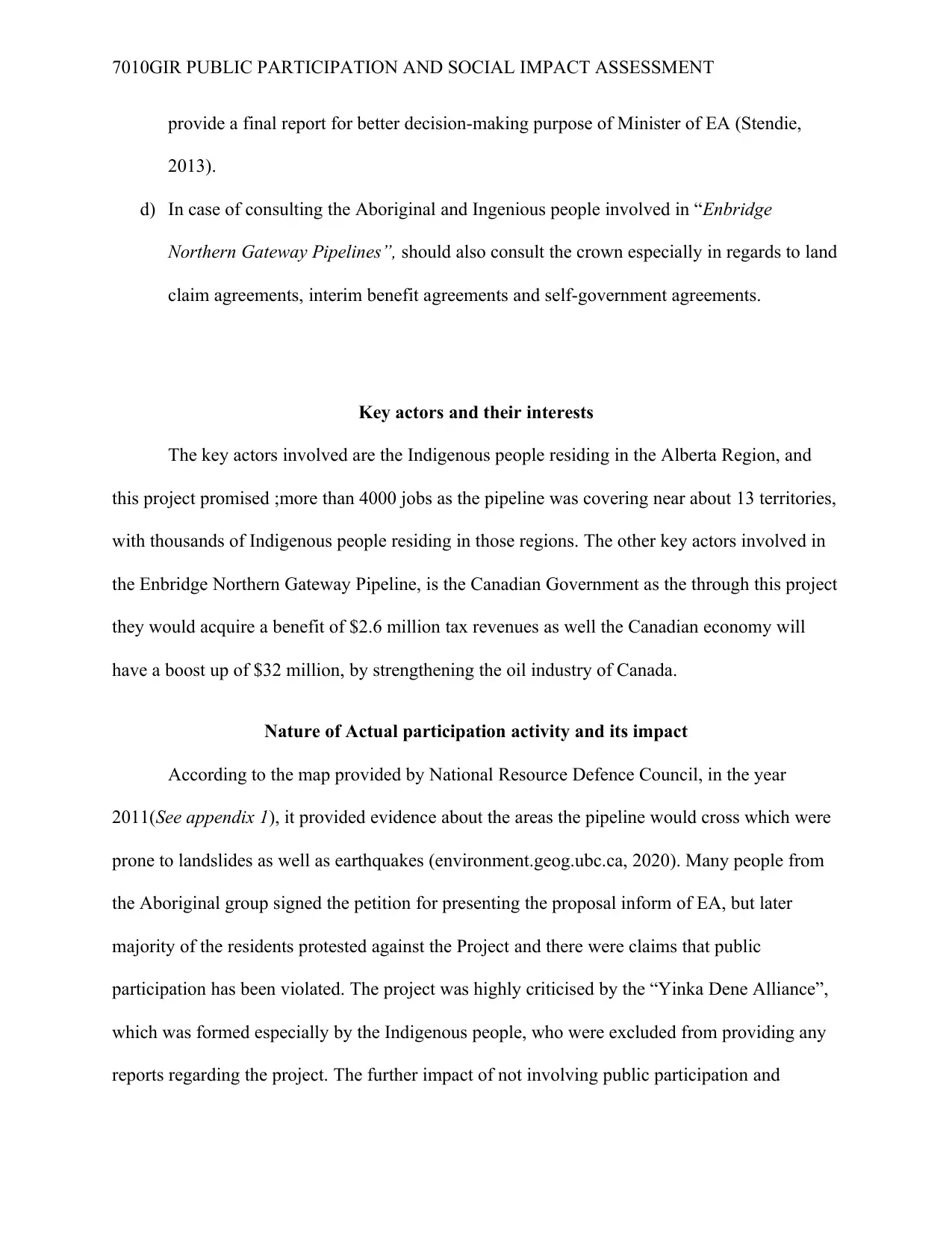
7010GIR PUBLIC PARTICIPATION AND SOCIAL IMPACT ASSESSMENT
provide a final report for better decision-making purpose of Minister of EA (Stendie,
2013).
d) In case of consulting the Aboriginal and Ingenious people involved in “Enbridge
Northern Gateway Pipelines”, should also consult the crown especially in regards to land
claim agreements, interim benefit agreements and self-government agreements.
Key actors and their interests
The key actors involved are the Indigenous people residing in the Alberta Region, and
this project promised ;more than 4000 jobs as the pipeline was covering near about 13 territories,
with thousands of Indigenous people residing in those regions. The other key actors involved in
the Enbridge Northern Gateway Pipeline, is the Canadian Government as the through this project
they would acquire a benefit of $2.6 million tax revenues as well the Canadian economy will
have a boost up of $32 million, by strengthening the oil industry of Canada.
Nature of Actual participation activity and its impact
According to the map provided by National Resource Defence Council, in the year
2011(See appendix 1), it provided evidence about the areas the pipeline would cross which were
prone to landslides as well as earthquakes (environment.geog.ubc.ca, 2020). Many people from
the Aboriginal group signed the petition for presenting the proposal inform of EA, but later
majority of the residents protested against the Project and there were claims that public
participation has been violated. The project was highly criticised by the “Yinka Dene Alliance”,
which was formed especially by the Indigenous people, who were excluded from providing any
reports regarding the project. The further impact of not involving public participation and
provide a final report for better decision-making purpose of Minister of EA (Stendie,
2013).
d) In case of consulting the Aboriginal and Ingenious people involved in “Enbridge
Northern Gateway Pipelines”, should also consult the crown especially in regards to land
claim agreements, interim benefit agreements and self-government agreements.
Key actors and their interests
The key actors involved are the Indigenous people residing in the Alberta Region, and
this project promised ;more than 4000 jobs as the pipeline was covering near about 13 territories,
with thousands of Indigenous people residing in those regions. The other key actors involved in
the Enbridge Northern Gateway Pipeline, is the Canadian Government as the through this project
they would acquire a benefit of $2.6 million tax revenues as well the Canadian economy will
have a boost up of $32 million, by strengthening the oil industry of Canada.
Nature of Actual participation activity and its impact
According to the map provided by National Resource Defence Council, in the year
2011(See appendix 1), it provided evidence about the areas the pipeline would cross which were
prone to landslides as well as earthquakes (environment.geog.ubc.ca, 2020). Many people from
the Aboriginal group signed the petition for presenting the proposal inform of EA, but later
majority of the residents protested against the Project and there were claims that public
participation has been violated. The project was highly criticised by the “Yinka Dene Alliance”,
which was formed especially by the Indigenous people, who were excluded from providing any
reports regarding the project. The further impact of not involving public participation and
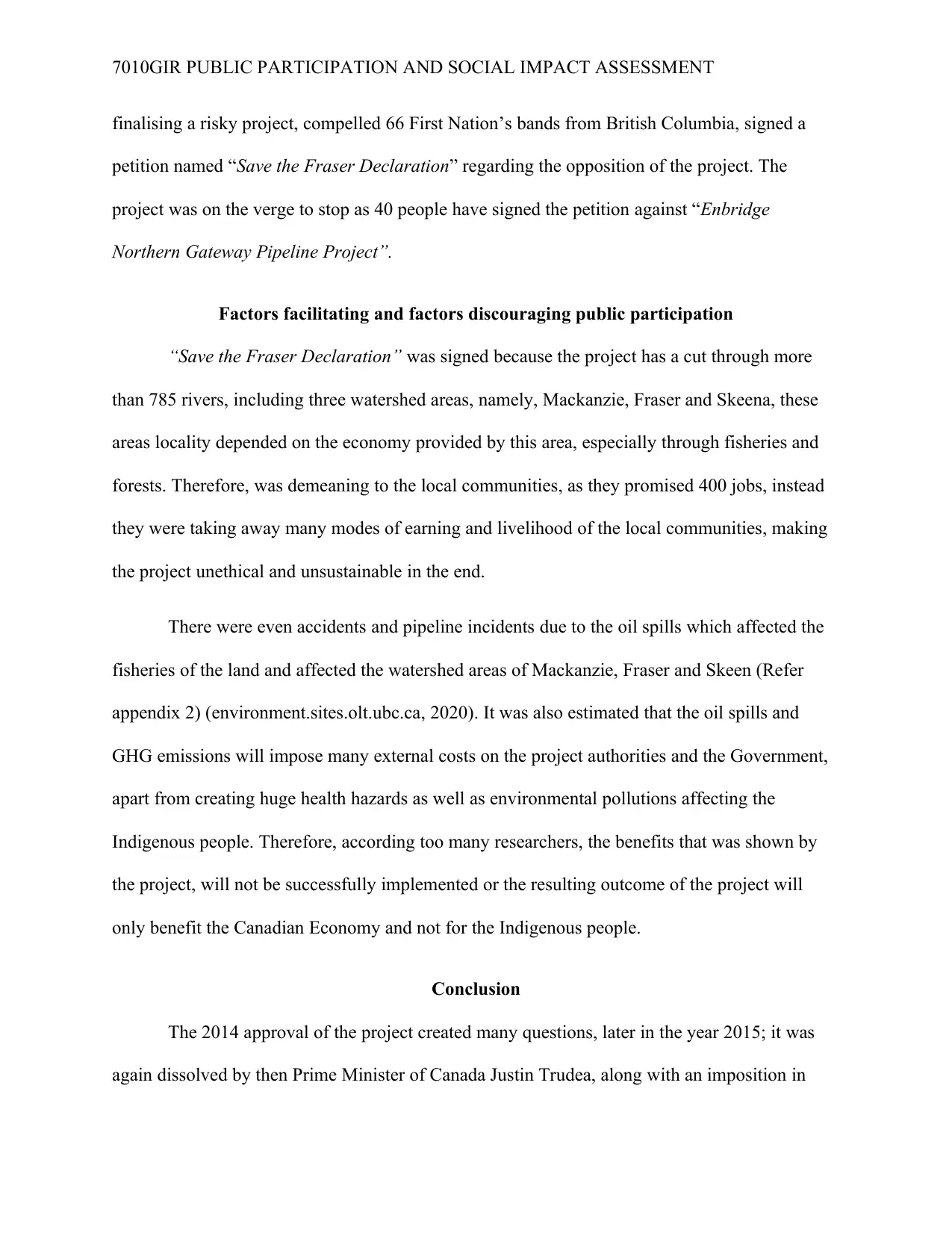
7010GIR PUBLIC PARTICIPATION AND SOCIAL IMPACT ASSESSMENT
finalising a risky project, compelled 66 First Nation’s bands from British Columbia, signed a
petition named “Save the Fraser Declaration” regarding the opposition of the project. The
project was on the verge to stop as 40 people have signed the petition against “Enbridge
Northern Gateway Pipeline Project”.
Factors facilitating and factors discouraging public participation
“Save the Fraser Declaration” was signed because the project has a cut through more
than 785 rivers, including three watershed areas, namely, Mackanzie, Fraser and Skeena, these
areas locality depended on the economy provided by this area, especially through fisheries and
forests. Therefore, was demeaning to the local communities, as they promised 400 jobs, instead
they were taking away many modes of earning and livelihood of the local communities, making
the project unethical and unsustainable in the end.
There were even accidents and pipeline incidents due to the oil spills which affected the
fisheries of the land and affected the watershed areas of Mackanzie, Fraser and Skeen (Refer
appendix 2) (environment.sites.olt.ubc.ca, 2020). It was also estimated that the oil spills and
GHG emissions will impose many external costs on the project authorities and the Government,
apart from creating huge health hazards as well as environmental pollutions affecting the
Indigenous people. Therefore, according too many researchers, the benefits that was shown by
the project, will not be successfully implemented or the resulting outcome of the project will
only benefit the Canadian Economy and not for the Indigenous people.
Conclusion
The 2014 approval of the project created many questions, later in the year 2015; it was
again dissolved by then Prime Minister of Canada Justin Trudea, along with an imposition in
finalising a risky project, compelled 66 First Nation’s bands from British Columbia, signed a
petition named “Save the Fraser Declaration” regarding the opposition of the project. The
project was on the verge to stop as 40 people have signed the petition against “Enbridge
Northern Gateway Pipeline Project”.
Factors facilitating and factors discouraging public participation
“Save the Fraser Declaration” was signed because the project has a cut through more
than 785 rivers, including three watershed areas, namely, Mackanzie, Fraser and Skeena, these
areas locality depended on the economy provided by this area, especially through fisheries and
forests. Therefore, was demeaning to the local communities, as they promised 400 jobs, instead
they were taking away many modes of earning and livelihood of the local communities, making
the project unethical and unsustainable in the end.
There were even accidents and pipeline incidents due to the oil spills which affected the
fisheries of the land and affected the watershed areas of Mackanzie, Fraser and Skeen (Refer
appendix 2) (environment.sites.olt.ubc.ca, 2020). It was also estimated that the oil spills and
GHG emissions will impose many external costs on the project authorities and the Government,
apart from creating huge health hazards as well as environmental pollutions affecting the
Indigenous people. Therefore, according too many researchers, the benefits that was shown by
the project, will not be successfully implemented or the resulting outcome of the project will
only benefit the Canadian Economy and not for the Indigenous people.
Conclusion
The 2014 approval of the project created many questions, later in the year 2015; it was
again dissolved by then Prime Minister of Canada Justin Trudea, along with an imposition in
⊘ This is a preview!⊘
Do you want full access?
Subscribe today to unlock all pages.

Trusted by 1+ million students worldwide
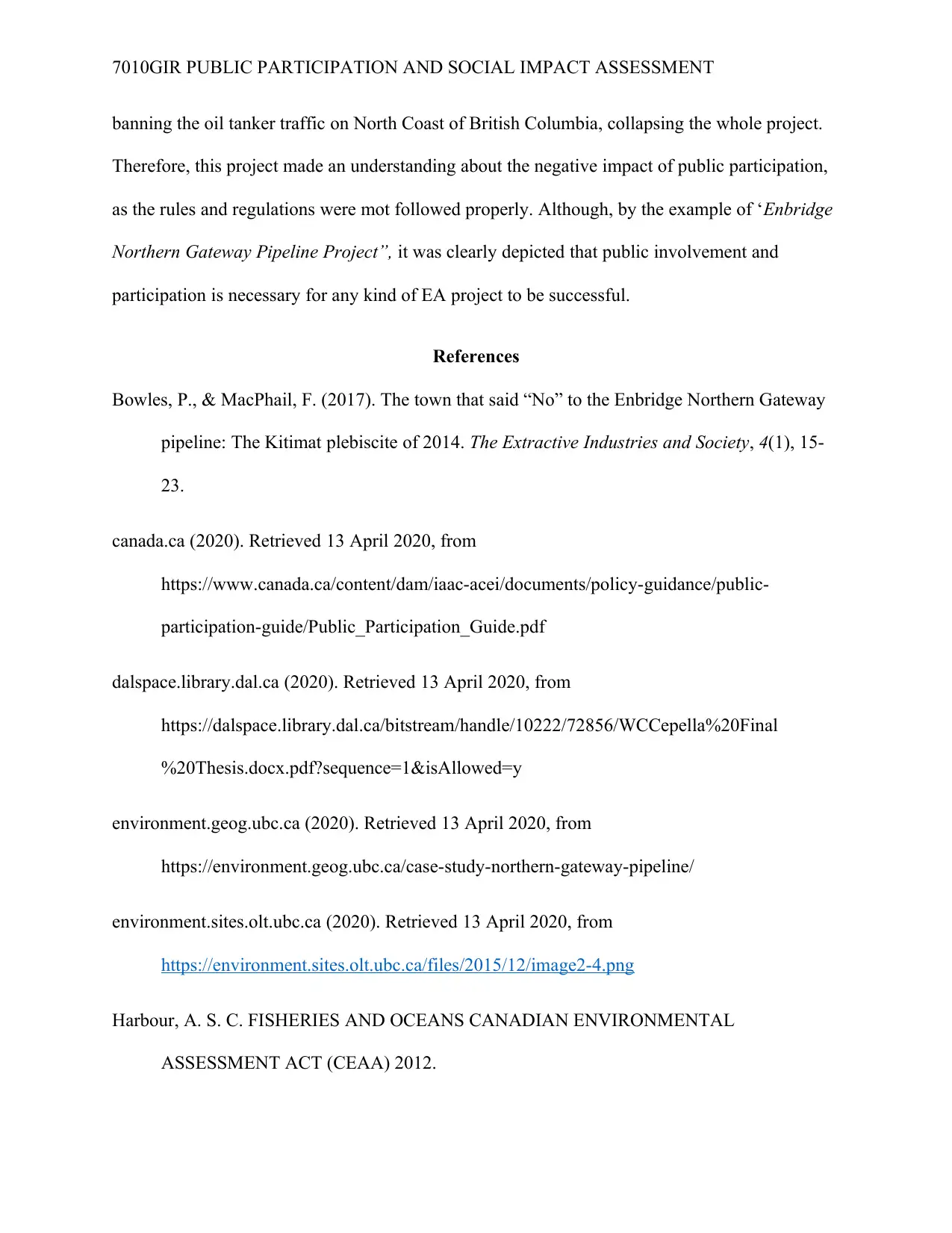
7010GIR PUBLIC PARTICIPATION AND SOCIAL IMPACT ASSESSMENT
banning the oil tanker traffic on North Coast of British Columbia, collapsing the whole project.
Therefore, this project made an understanding about the negative impact of public participation,
as the rules and regulations were mot followed properly. Although, by the example of ‘Enbridge
Northern Gateway Pipeline Project”, it was clearly depicted that public involvement and
participation is necessary for any kind of EA project to be successful.
References
Bowles, P., & MacPhail, F. (2017). The town that said “No” to the Enbridge Northern Gateway
pipeline: The Kitimat plebiscite of 2014. The Extractive Industries and Society, 4(1), 15-
23.
canada.ca (2020). Retrieved 13 April 2020, from
https://www.canada.ca/content/dam/iaac-acei/documents/policy-guidance/public-
participation-guide/Public_Participation_Guide.pdf
dalspace.library.dal.ca (2020). Retrieved 13 April 2020, from
https://dalspace.library.dal.ca/bitstream/handle/10222/72856/WCCepella%20Final
%20Thesis.docx.pdf?sequence=1&isAllowed=y
environment.geog.ubc.ca (2020). Retrieved 13 April 2020, from
https://environment.geog.ubc.ca/case-study-northern-gateway-pipeline/
environment.sites.olt.ubc.ca (2020). Retrieved 13 April 2020, from
https://environment.sites.olt.ubc.ca/files/2015/12/image2-4.png
Harbour, A. S. C. FISHERIES AND OCEANS CANADIAN ENVIRONMENTAL
ASSESSMENT ACT (CEAA) 2012.
banning the oil tanker traffic on North Coast of British Columbia, collapsing the whole project.
Therefore, this project made an understanding about the negative impact of public participation,
as the rules and regulations were mot followed properly. Although, by the example of ‘Enbridge
Northern Gateway Pipeline Project”, it was clearly depicted that public involvement and
participation is necessary for any kind of EA project to be successful.
References
Bowles, P., & MacPhail, F. (2017). The town that said “No” to the Enbridge Northern Gateway
pipeline: The Kitimat plebiscite of 2014. The Extractive Industries and Society, 4(1), 15-
23.
canada.ca (2020). Retrieved 13 April 2020, from
https://www.canada.ca/content/dam/iaac-acei/documents/policy-guidance/public-
participation-guide/Public_Participation_Guide.pdf
dalspace.library.dal.ca (2020). Retrieved 13 April 2020, from
https://dalspace.library.dal.ca/bitstream/handle/10222/72856/WCCepella%20Final
%20Thesis.docx.pdf?sequence=1&isAllowed=y
environment.geog.ubc.ca (2020). Retrieved 13 April 2020, from
https://environment.geog.ubc.ca/case-study-northern-gateway-pipeline/
environment.sites.olt.ubc.ca (2020). Retrieved 13 April 2020, from
https://environment.sites.olt.ubc.ca/files/2015/12/image2-4.png
Harbour, A. S. C. FISHERIES AND OCEANS CANADIAN ENVIRONMENTAL
ASSESSMENT ACT (CEAA) 2012.
Paraphrase This Document
Need a fresh take? Get an instant paraphrase of this document with our AI Paraphraser
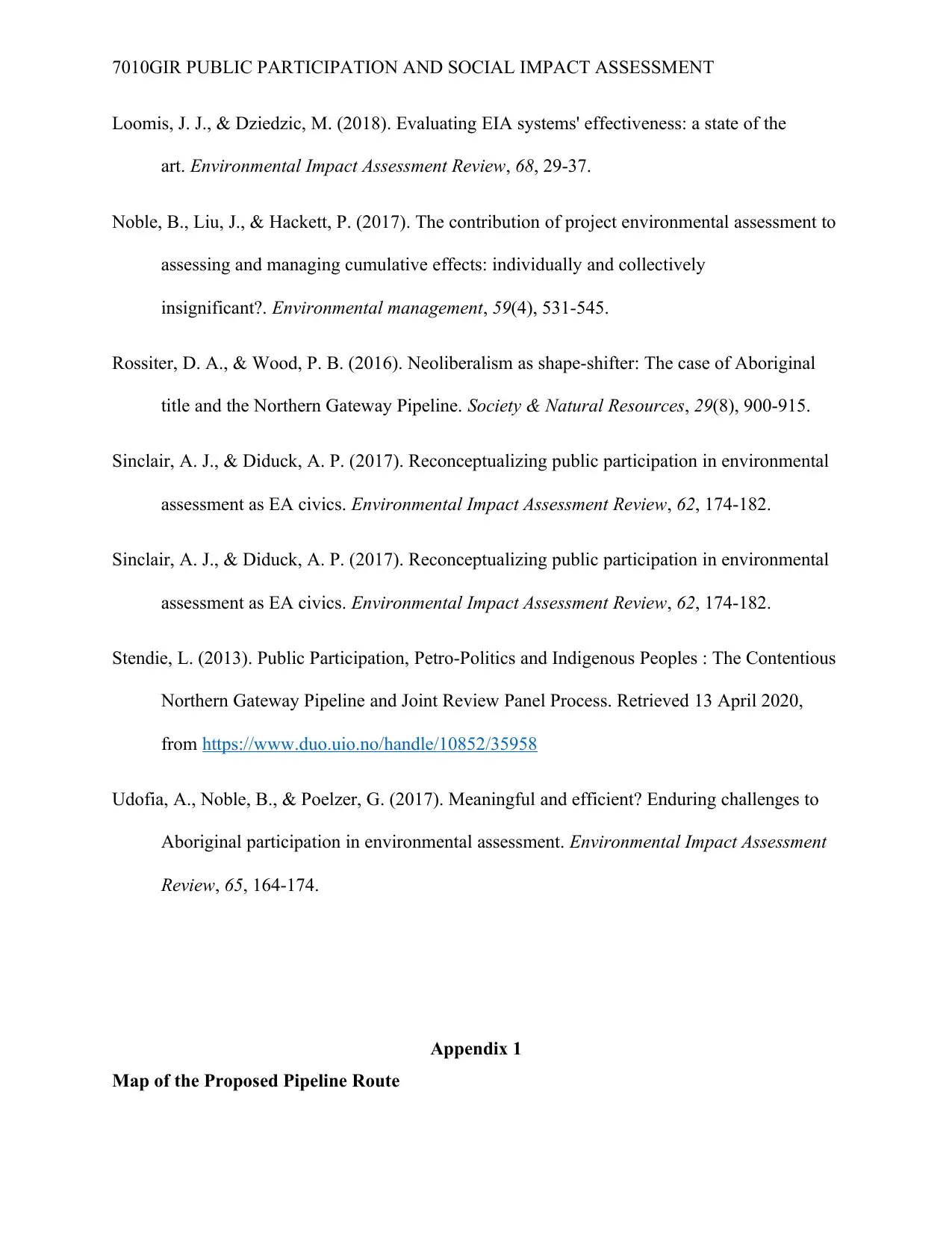
7010GIR PUBLIC PARTICIPATION AND SOCIAL IMPACT ASSESSMENT
Loomis, J. J., & Dziedzic, M. (2018). Evaluating EIA systems' effectiveness: a state of the
art. Environmental Impact Assessment Review, 68, 29-37.
Noble, B., Liu, J., & Hackett, P. (2017). The contribution of project environmental assessment to
assessing and managing cumulative effects: individually and collectively
insignificant?. Environmental management, 59(4), 531-545.
Rossiter, D. A., & Wood, P. B. (2016). Neoliberalism as shape-shifter: The case of Aboriginal
title and the Northern Gateway Pipeline. Society & Natural Resources, 29(8), 900-915.
Sinclair, A. J., & Diduck, A. P. (2017). Reconceptualizing public participation in environmental
assessment as EA civics. Environmental Impact Assessment Review, 62, 174-182.
Sinclair, A. J., & Diduck, A. P. (2017). Reconceptualizing public participation in environmental
assessment as EA civics. Environmental Impact Assessment Review, 62, 174-182.
Stendie, L. (2013). Public Participation, Petro-Politics and Indigenous Peoples : The Contentious
Northern Gateway Pipeline and Joint Review Panel Process. Retrieved 13 April 2020,
from https://www.duo.uio.no/handle/10852/35958
Udofia, A., Noble, B., & Poelzer, G. (2017). Meaningful and efficient? Enduring challenges to
Aboriginal participation in environmental assessment. Environmental Impact Assessment
Review, 65, 164-174.
Appendix 1
Map of the Proposed Pipeline Route
Loomis, J. J., & Dziedzic, M. (2018). Evaluating EIA systems' effectiveness: a state of the
art. Environmental Impact Assessment Review, 68, 29-37.
Noble, B., Liu, J., & Hackett, P. (2017). The contribution of project environmental assessment to
assessing and managing cumulative effects: individually and collectively
insignificant?. Environmental management, 59(4), 531-545.
Rossiter, D. A., & Wood, P. B. (2016). Neoliberalism as shape-shifter: The case of Aboriginal
title and the Northern Gateway Pipeline. Society & Natural Resources, 29(8), 900-915.
Sinclair, A. J., & Diduck, A. P. (2017). Reconceptualizing public participation in environmental
assessment as EA civics. Environmental Impact Assessment Review, 62, 174-182.
Sinclair, A. J., & Diduck, A. P. (2017). Reconceptualizing public participation in environmental
assessment as EA civics. Environmental Impact Assessment Review, 62, 174-182.
Stendie, L. (2013). Public Participation, Petro-Politics and Indigenous Peoples : The Contentious
Northern Gateway Pipeline and Joint Review Panel Process. Retrieved 13 April 2020,
from https://www.duo.uio.no/handle/10852/35958
Udofia, A., Noble, B., & Poelzer, G. (2017). Meaningful and efficient? Enduring challenges to
Aboriginal participation in environmental assessment. Environmental Impact Assessment
Review, 65, 164-174.
Appendix 1
Map of the Proposed Pipeline Route
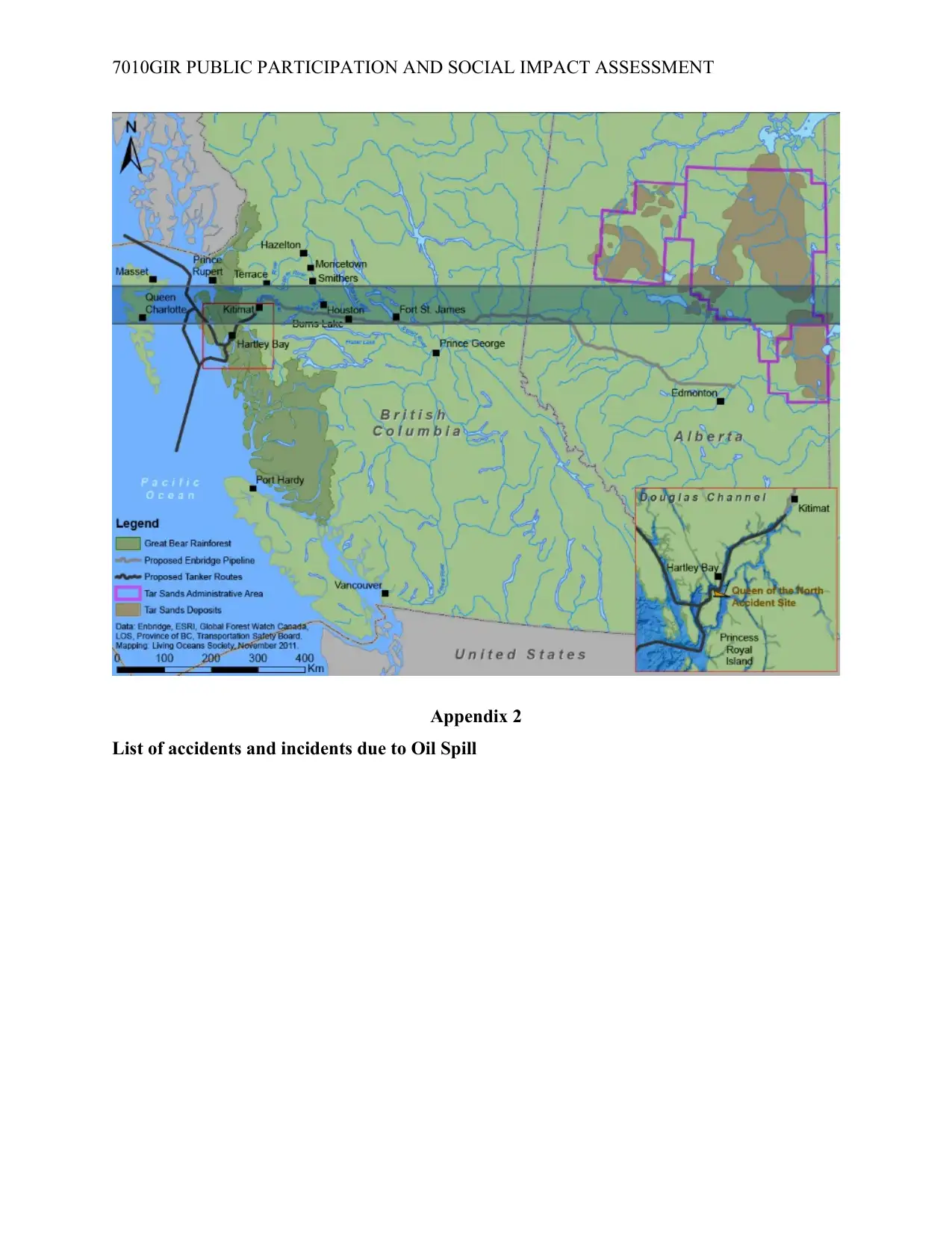
7010GIR PUBLIC PARTICIPATION AND SOCIAL IMPACT ASSESSMENT
Appendix 2
List of accidents and incidents due to Oil Spill
Appendix 2
List of accidents and incidents due to Oil Spill
⊘ This is a preview!⊘
Do you want full access?
Subscribe today to unlock all pages.

Trusted by 1+ million students worldwide
1 out of 13
Your All-in-One AI-Powered Toolkit for Academic Success.
+13062052269
info@desklib.com
Available 24*7 on WhatsApp / Email
![[object Object]](/_next/static/media/star-bottom.7253800d.svg)
Unlock your academic potential
Copyright © 2020–2025 A2Z Services. All Rights Reserved. Developed and managed by ZUCOL.